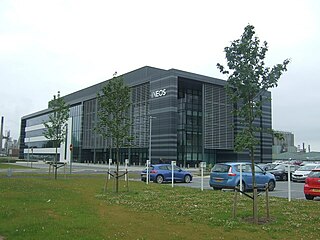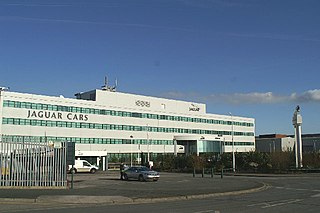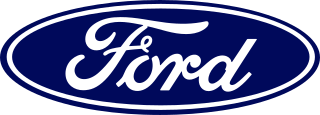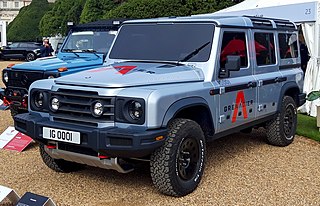
Land Rover is a British brand of predominantly four-wheel drive, off-road capable vehicles, owned by multinational car manufacturer Jaguar Land Rover (JLR), since 2008 a subsidiary of India's Tata Motors. JLR currently builds Land Rovers in Brazil, China, India, Slovakia, and the United Kingdom. The Land Rover name was created in 1948 by the Rover Company for a utilitarian 4WD off-road vehicle; currently, the Land Rover range consists solely of upmarket and luxury sport utility vehicles.
The Volvo Group is a Swedish multinational manufacturing corporation headquartered in Gothenburg. While its core activity is the production, distribution and sale of trucks, buses and construction equipment, Volvo also supplies marine and industrial drive systems and financial services. In 2016, it was the world's second-largest manufacturer of heavy-duty trucks with its subsidiary Volvo Trucks.

Jaguar is the sports car and luxury vehicle brand of Jaguar Land Rover, a British multinational car manufacturer with its headquarters in Whitley, Coventry, England. Jaguar Cars was the company that was responsible for the production of Jaguar cars until its operations were fully merged with those of Land Rover to form Jaguar Land Rover on 1 January 2013.
The automotive industry in the United Kingdom is now best known for premium and sports car marques including Aston Martin, Bentley, Caterham Cars, Daimler, Jaguar, Lagonda, Land Rover, Lister Cars, Lotus, MG, McLaren, Mini, MOKE, Morgan, Rolls-Royce and TVR. Volume car manufacturers with a major presence in the UK include Nissan, Toyota, BMW, and Vauxhall Motors. Commercial vehicle manufacturers active in the UK include Alexander Dennis, Dennis Eagle, IBC Vehicles, Leyland Trucks, TEVVA and London Electric Vehicle Company.

British Leyland was an automotive engineering and manufacturing conglomerate formed in the United Kingdom in 1968 as British Leyland Motor Corporation Ltd (BLMC), following the merger of Leyland Motors and British Motor Holdings. It was partly nationalised in 1975, when the UK government created a holding company called British Leyland, later renamed BL in 1978. It incorporated much of the British-owned motor vehicle industry, which in 1968 had a 40% share of the UK car market, with its history going back to 1895. Despite containing profitable marques such as Jaguar, Rover, and Land Rover, as well as the best-selling Mini, BLMC had a troubled history, leading to its eventual collapse in 1975 and subsequent part-nationalisation.

Bridgend is a town in the Bridgend County Borough of Wales, 20 miles (32 km) west of Cardiff and 20 miles (32 km) east of Swansea. The town is named after the medieval bridge over the River Ogmore. The River Ewenny also flows through the town. The population was 49,597 in 2021. Bridgend is within the Cardiff Capital Region which in 2019 had a population of approximately 1.54 million.
The Premier Automotive Group (PAG) was an organizational division within the Ford Motor Company formed in 1999 to oversee the business operations of Ford's high-end automotive marques. The PAG was gradually dismantled from 2006 to 2011 with the divestiture of its constituent brands.

Tata Motors Limited is an Indian multinational automotive company, headquartered in Mumbai and part of the Tata Group. The company produces cars, trucks, vans, and busses.

The Jaguar AJ-8 is a compact DOHC V8 piston engine used in many Jaguar vehicles. It was the fourth new engine type in the history of the company. It was an in house design with work beginning before Ford's purchase of the company. In 1997 it replaced both designs previously available on Jaguar cars: the straight-6 Jaguar AJ6 engine, and the Jaguar V12 engine. It remained the only engine type available on Jaguar until 1999 with the launch of the S-Type, when the Jaguar AJ-V6 engine was added to the list. The AJ-V8 is available in displacements ranging from 3.2L to 5.0L, and a supercharged version is also produced. Ford Motor Company also used this engine in other cars, including the Lincoln LS and the 2002–2005 Ford Thunderbird, as well as in several Land Rovers, and the Aston Martin V8 Vantage.

Ineos Group Limited is a British multinational conglomerate headquartered and registered in London. As of 2021, it is the fourth largest chemical company in the world, with additional operations in fuel, packaging and food, construction, automotive, pharmaceuticals, textiles, and professional sports. Ineos is organised into about 20 standalone business units, each with its own board and operating almost entirely independently, although founder Jim Ratcliffe, who owns a controlling interest, and his associates, who collectively own a minority share, sit on their boards occasionally.

Smartville is a purpose-built factory complex in Hambach, France, established in 1994 as a joint venture of Daimler-Benz and the Swiss watch manufacturer Swatch to produce the Smart car. In 2020 the plant was 100% owned by Daimler AG and was taken over by Ineos for production of the Ineos Grenadier 4x4.

Castle Bromwich Assembly is a factory owned by Jaguar Land Rover. It is located on the Chester Road in Castle Vale, Birmingham, England and employs 3,200 people. The plant is situated on a 110-acre (45 ha) site, with a 60,000 square metres (650,000 sq ft) manufacturing facility. It manufactures all Jaguar saloon and sports cars.

Jaguar Land Rover Halewood is a Jaguar Land Rover factory plant in Halewood, Merseyside, England, and forms the major part of the factory complex in Halewood which is shared with Ford of Britain who manufacture transmissions at the site, and who opened the site in 1962 as their Halewood Body & Assembly plant.

Ford India Private Limited was a subsidiary of Ford Motor Company for its operations in India. Ford India Private Limited's headquarter is located in Sholinganallur, Chennai, Tamil Nadu. Ford also had operated integrated manufacturing facilities in Sanand, Gujarat. On September 9, 2021, Ford exited the Indian market as it failed to keep up with the competition, and other global economic factors had led to reduction in demand. On 8 August 2022, Ford announced it would be selling its manufacturing plant in the western state of Gujarat for INR 7.26 billion to Tata Motors. Since 2021, Ford India has focused on the businesses of supporting a service network, import and distribution of automotive parts, and the sale of extended warranties.

Jaguar Land Rover Automotive PLC is the holding company of Jaguar Land Rover Limited, also known as JLR, and is a British multinational automobile manufacturer which produces luxury vehicles and sport utility vehicles. Jaguar Land Rover is a subsidiary of Tata Motors and has its head office in Whitley, Coventry, UK. The principal activity of Jaguar Land Rover Limited is the design, development, manufacture and sale of vehicles bearing the Jaguar and Land Rover marques.

EcoBoost is a series of turbocharged, direct-injection gasoline engines produced by Ford and originally co-developed by FEV Inc.. EcoBoost engines are designed to deliver power and torque consistent with those of larger-displacement naturally aspirated engines, while achieving up to 20% better fuel efficiency and 15% fewer greenhouse emissions, according to Ford. The manufacturer sees the EcoBoost technology as less costly and more versatile than further developing or expanding the use of hybrid and diesel engine technologies. EcoBoost engines are broadly available across the Ford vehicle lineup.
Honda of the UK Manufacturing Ltd was a British automotive manufacturing company, and the United Kingdom-based manufacturing subsidiary of the multinational automotive company Honda. Based in Swindon, England, HUM operated manufacturing plants that included casting, engine assembly, pressing, welding, painting, and car assembly activities. At the time of its closure, it employed around 3,400 people at the plants, which occupied a site covering around 370 acres.

Solihull plant is a car manufacturing factory in Lode Lane, Lode Heath, Solihull, UK, owned by Jaguar Land Rover. The plant sits on a 300-acre (120 ha) site and employs over 9,000 people in manufacturing.

The Ineos Grenadier is an off-road utility vehicle designed and produced by Ineos Automotive Ltd. It went into production in October 2022. The Grenadier was designed to be a modern replacement of the original Land Rover Defender, with boxy bodywork, a steel ladder chassis, beam axles with long-travel progressive-rate coil spring suspension, and powered by BMW six-cylinder internal combustion engine Diesels.

Ineos Automotive Ltd is British manufacturer of off-road vehicles based in London, operating since 2016. It belongs to the multinational conglomerate Ineos.

















